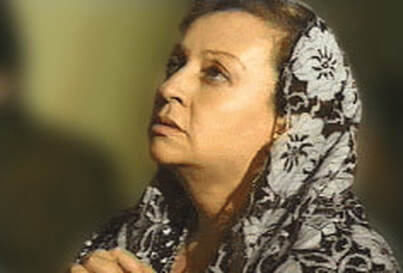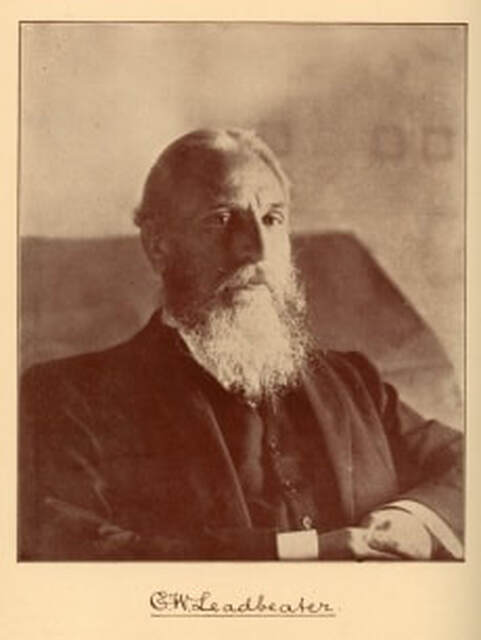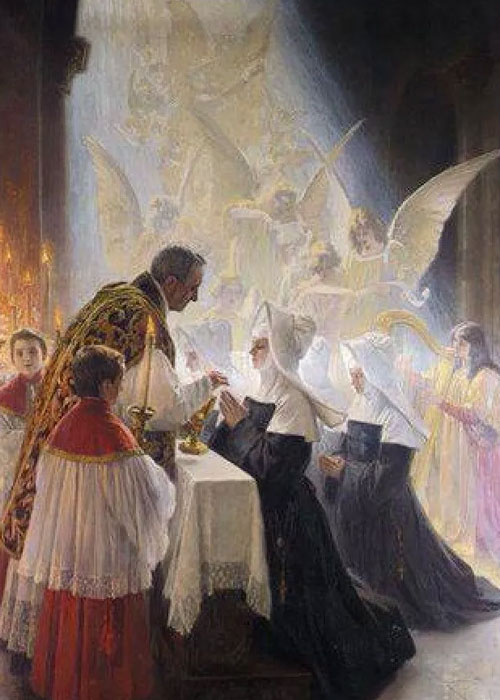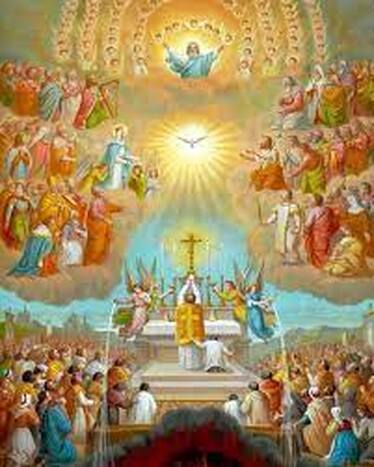ANGELS AT MASS. A CROSS-READING OF THE WRITINGS OF CATALINA RIVAS AND CHARLES WEBSTER LEADBEATER.
by Revd Fr Giovanni Pede
The mystic and the theosophist. Same phenomena, different readings.
I recently came across the story of the Roman Catholic mystic Catalina Rivas, who wrote down an account of her visions of what happens at Mass. The strength and clarity of the images she gives reminded me of the Liberal Catholic bishop Charles Webster Leadbeater's description of the liturgy and its "workings" in his magnum opus "The Science of the Sacraments" (1920). Obviously the latter refers to the Liberal Catholic Liturgy (1919) and the Tridentine liturgy with which it shows many similarities. Catalina Rivas's visions, on the other hand, date from the late 1990s and thus the rite of the Mass to which she refers is the Roman Novus Ordo.
The differences in the rite do not concern us in this article, as what I propose here is a cross-reading of the two testimonies.
A few words about Rivas and Leadbeater before taking up some fragments from their writings.
Catalina Rivas [1944 - ] is a Bolivian mystic who during the last decade of the last century was chosen by Jesus to become "his secretary" (as the mystic refers to herself and her ministry). Rivas received several messages full of mystical and religious significance, which she transcribed into several notebook pages, later published with the imprimatur of the Archbishop of Cochabamba. In the opinion of the Church, and of the mystic herself, the complexity of these texts was considered too high for her level of education and theological instruction. Catalina Rivas also received the stigmata in 1996.
I recently came across the story of the Roman Catholic mystic Catalina Rivas, who wrote down an account of her visions of what happens at Mass. The strength and clarity of the images she gives reminded me of the Liberal Catholic bishop Charles Webster Leadbeater's description of the liturgy and its "workings" in his magnum opus "The Science of the Sacraments" (1920). Obviously the latter refers to the Liberal Catholic Liturgy (1919) and the Tridentine liturgy with which it shows many similarities. Catalina Rivas's visions, on the other hand, date from the late 1990s and thus the rite of the Mass to which she refers is the Roman Novus Ordo.
The differences in the rite do not concern us in this article, as what I propose here is a cross-reading of the two testimonies.
A few words about Rivas and Leadbeater before taking up some fragments from their writings.
Catalina Rivas [1944 - ] is a Bolivian mystic who during the last decade of the last century was chosen by Jesus to become "his secretary" (as the mystic refers to herself and her ministry). Rivas received several messages full of mystical and religious significance, which she transcribed into several notebook pages, later published with the imprimatur of the Archbishop of Cochabamba. In the opinion of the Church, and of the mystic herself, the complexity of these texts was considered too high for her level of education and theological instruction. Catalina Rivas also received the stigmata in 1996.
Charles Webster Leadbeater [1854 - 1934], a former Anglican priest, became an exponent of the Theosophical Society and, in the 1910s, together with Bishop James Ingall Wedgwood, initiated the Liberal Catholic Church. The Liberal Catholic Church, initially known as the Old-Catholic Church of the British Isles, became an independent Catholic church when it broke away from the Utrecht Union. It was traditionalist in liturgy and ceremony, progressive socially and liberal theologically. Today, the Liberal Catholic Church is fragmented into various ecclesial realities of varying size, but with a global presence.
What happens during the Mass?
Let us now turn to the testimony of the two authors. Catalina Rivas wrote "La Santa Misa" in 2000, an account of a Mass she attended in the company of Our Lady, from whom she received various teachings and revelations. Rivas, moreover, touched by the Lord, is able to perceive "presences, energies and subtle forces" that come into play during the celebration. In particular, she witnesses the presence of angelic visitors who appear during the Offertory:
Suddenly some characters, whom I had not seen before, began to stand up. It was as if from the side of each person present in the Cathedral, another person emerged, and soon the Cathedral became full of young, beautiful people. They were dressed in very white robes, and they started to move into the central aisle and, then, went towards the Altar.
Our Mother said: “Observe. They are the Guardian Angels of each one of the persons who are here. This is the moment in which your guardian angel carries your offerings and petitions before the Altar of the Lord.”
In the Liberal Rite, at the end of the incensing of the offerings, after the Offertory, the priest addresses this request to God:
Let Thy holy Angels encompass Thy people and breathe forth upon them the spirit of Thy blessing.
Leadbeater describes what happens next:
it is a most beautiful sight to see them [the Angels] swoop down the church shedding their influence over the congregation...
Rivas continues in describing her vision:
Some of them were carrying something like a golden bowl with something that shone a great deal with a golden-white light. The Virgin Mary said: “They are the Guardian Angels of the people who are offering this Holy Mass for many intentions, those who are conscious of what this celebration means. They have something to offer the Lord.”
In “The Science of the Sacraments”, Leadbeater himself reports that the role of the Angels is precisely to gather the energies and intentions of those present and bring them to the Altar. The Liberal Catholic tradition places great emphasis on the formation of the faithful in liturgical matters, so that they are aware of what is happening during the Mass and so that they can conform their intentions and thoughts to the mystery being celebrated.
In the Preface of the Liberal Rite, the help of the angelic hosts is invoked, whose voices the celebrants and the faithful must join in singing the Sanctus. Leadbeater says:
It is indeed a marvellous and a glorious sight for the clairvoyant to see these celestial visitors flash into their appointed positions in response to their traditional words of power. While the Angel of the Eucharist stands usually beside the celebrant, or floats just above his head, the illustrious ambassadors of the nine Orders always range themselves behind the Altar facing the celebrant. Behind them in turn stand numbers of human beings as well, whose members generally take their places opposite the ends of the Altar, though they frequently also fill the upper part of the nave, hovering above those who are still in the body.
Catholics who during their physical lives have delighted in the Services of the Church naturally continue to attend them after the death of their bodies; [...] the worshippers whom most people cannot see are often far more numerous than those perceptible to all.
Let’s go back to Rivas’ vision. At the singing of the Sanctus, Catalina sees a host of Angels…
Behind the left side of the Archbishop, thousands of Angels appeared in a diagonal line, small angels, big angels, angels with immense wings, angels with small wings, angels without wings. As the previous ones, all were dressed with tunics like the white robes of the priests or altar boys. Everyone knelt with their hands united in prayer, and bowed their heads in reverence. Beautiful music was heard as if there were many choirs with different voices, all singing in unison together with the people: Holy, Holy, Holy…
..and many people dressed in robes of various colours. Mary reveals to her that they are “all the Saints and the Blessed of Heaven, and among them are the souls of your relatives who already enjoy the Presence of God”.
She continues as follow:
Before the Altar, there appeared some shadows of people in a gray color with their hands raised. The Holy Virgin said: “These are the blessed souls of Purgatory, who await your prayers to be refreshed. Do not stop praying for them. They pray for you, but they cannot pray for themselves. It is you who have to pray for them, in order to help them depart so that they can be with God and enjoy Him eternally.
In the Liberal Catholic tradition the concept of Purgatory is different from that of the Roman Church. The interpretation, and therefore the explanation that the two authors give of the vision is different, but what they see happening is very similar: the souls of the dead are also present during the celebration of the Holy Mass.
We now come to the moment of the Consecration. Rivas continues her narration in this way.
The celebrant said the words of the Consecration. He was a person of normal height, but suddenly, he began to grow, becoming filled with light, a supernatural light between white and gold that enveloped him and grew very strong around the face. And because of it, I could not see his features. When he raised the Host, I saw his hands, and on the back of his hands, he had some marks from which emanated a great deal of light. [...]
Immediately, the Archbishop said the words of the Consecration of the wine and, as the words were being said, lightning appeared from the heavens and in the background. The walls and ceiling of the church had disappeared. All was dark, but for that brilliant light from the Altar.
Let us now turn to the testimony of the two authors. Catalina Rivas wrote "La Santa Misa" in 2000, an account of a Mass she attended in the company of Our Lady, from whom she received various teachings and revelations. Rivas, moreover, touched by the Lord, is able to perceive "presences, energies and subtle forces" that come into play during the celebration. In particular, she witnesses the presence of angelic visitors who appear during the Offertory:
Suddenly some characters, whom I had not seen before, began to stand up. It was as if from the side of each person present in the Cathedral, another person emerged, and soon the Cathedral became full of young, beautiful people. They were dressed in very white robes, and they started to move into the central aisle and, then, went towards the Altar.
Our Mother said: “Observe. They are the Guardian Angels of each one of the persons who are here. This is the moment in which your guardian angel carries your offerings and petitions before the Altar of the Lord.”
In the Liberal Rite, at the end of the incensing of the offerings, after the Offertory, the priest addresses this request to God:
Let Thy holy Angels encompass Thy people and breathe forth upon them the spirit of Thy blessing.
Leadbeater describes what happens next:
it is a most beautiful sight to see them [the Angels] swoop down the church shedding their influence over the congregation...
Rivas continues in describing her vision:
Some of them were carrying something like a golden bowl with something that shone a great deal with a golden-white light. The Virgin Mary said: “They are the Guardian Angels of the people who are offering this Holy Mass for many intentions, those who are conscious of what this celebration means. They have something to offer the Lord.”
In “The Science of the Sacraments”, Leadbeater himself reports that the role of the Angels is precisely to gather the energies and intentions of those present and bring them to the Altar. The Liberal Catholic tradition places great emphasis on the formation of the faithful in liturgical matters, so that they are aware of what is happening during the Mass and so that they can conform their intentions and thoughts to the mystery being celebrated.
In the Preface of the Liberal Rite, the help of the angelic hosts is invoked, whose voices the celebrants and the faithful must join in singing the Sanctus. Leadbeater says:
It is indeed a marvellous and a glorious sight for the clairvoyant to see these celestial visitors flash into their appointed positions in response to their traditional words of power. While the Angel of the Eucharist stands usually beside the celebrant, or floats just above his head, the illustrious ambassadors of the nine Orders always range themselves behind the Altar facing the celebrant. Behind them in turn stand numbers of human beings as well, whose members generally take their places opposite the ends of the Altar, though they frequently also fill the upper part of the nave, hovering above those who are still in the body.
Catholics who during their physical lives have delighted in the Services of the Church naturally continue to attend them after the death of their bodies; [...] the worshippers whom most people cannot see are often far more numerous than those perceptible to all.
Let’s go back to Rivas’ vision. At the singing of the Sanctus, Catalina sees a host of Angels…
Behind the left side of the Archbishop, thousands of Angels appeared in a diagonal line, small angels, big angels, angels with immense wings, angels with small wings, angels without wings. As the previous ones, all were dressed with tunics like the white robes of the priests or altar boys. Everyone knelt with their hands united in prayer, and bowed their heads in reverence. Beautiful music was heard as if there were many choirs with different voices, all singing in unison together with the people: Holy, Holy, Holy…
..and many people dressed in robes of various colours. Mary reveals to her that they are “all the Saints and the Blessed of Heaven, and among them are the souls of your relatives who already enjoy the Presence of God”.
She continues as follow:
Before the Altar, there appeared some shadows of people in a gray color with their hands raised. The Holy Virgin said: “These are the blessed souls of Purgatory, who await your prayers to be refreshed. Do not stop praying for them. They pray for you, but they cannot pray for themselves. It is you who have to pray for them, in order to help them depart so that they can be with God and enjoy Him eternally.
In the Liberal Catholic tradition the concept of Purgatory is different from that of the Roman Church. The interpretation, and therefore the explanation that the two authors give of the vision is different, but what they see happening is very similar: the souls of the dead are also present during the celebration of the Holy Mass.
We now come to the moment of the Consecration. Rivas continues her narration in this way.
The celebrant said the words of the Consecration. He was a person of normal height, but suddenly, he began to grow, becoming filled with light, a supernatural light between white and gold that enveloped him and grew very strong around the face. And because of it, I could not see his features. When he raised the Host, I saw his hands, and on the back of his hands, he had some marks from which emanated a great deal of light. [...]
Immediately, the Archbishop said the words of the Consecration of the wine and, as the words were being said, lightning appeared from the heavens and in the background. The walls and ceiling of the church had disappeared. All was dark, but for that brilliant light from the Altar.
Leadbeater wrote 'The Science of the Sacraments' following a similar vision he had during a Roman Catholic celebration he attended on a visit to Sicily, reported in an article in The Theosophist magazine in 1910:
At the moment of consecration the Host glowed with the most dazzling brightness; it became in fact a veritable sun to the eye of the clairvoyant, and as the priest lifted it above the heads of the people I noticed that two distinct varieties of spiritual force poured forth from it, which might perhaps be taken as roughly corresponding to the light of the sun and the streamers of his corona. The first rayed out impartially in all directions upon all the people in the church; indeed it penetrated the walls of the church as though they were not there, and influenced a considerable section of the surrounding country
All those present are touched by that light, which emanates from the Blessed Sacrament onto all the people. This also happens according to the vision of Rivas:
From within this resplendent light, a small light, like a very brilliant, very small dove, came forth and flew swiftly all over the Church. It came to rest on the left shoulder of the Archbishop..
We now come to the moment of Communion. Catalina observes the faithful waiting to receive the Body of Christ. Jesus himself appears at the side of the mystic to instruct her.
When the Priest placed the Sacred Host on her tongue, a flash of light, like a very golden white light, went right through this person, first through her back, then surrounding her from the back, around her shoulders, and then her head. The Lord said: “This is how I Myself rejoice in embracing a soul who comes with a clean heart to receive Me.”
Leadbeater, for his part, reports that the communicant, in taking Holy Communion, draws enormous "waves of force" to himself.
Not only is the communicant stimulated and strengthened in every way by coming into so close a relation with this splendid manifestation of the divine power, but he himself becomes for the time a subsidiary centre of that power, and radiates it in turn upon those around him [...] [He] becomes a radiant sun among his brethren.
The Liberal Catholic Post-Communio reads as follows: “We who have been refreshed with Thy heavenly gifts, do pray Thee, O Lord, that Thy grace may be so grafted inwardly in our hearts, that it may continually be made manifest in our lives”. Leadbeater explains that this prayer is intended to ensure that the stimulus we receive does not turn into a mere feeling, but continues to do its work within us. Ordinary life continues under the radiance of the Eucharistic light.
Catalina, after having observed the faithful taking Communion, asks the Lord how long He remains present after Mass. Jesus answers her thus: "All the time that you want to have Me with you. If you speak to Me all day long, offering Me some words during your chores, I will listen to you. I am always with you. It is you who leaves Me".
Both authors agree that the effects of the Eucharist do not end with the reception of the Blessed Sacrament, but continue in the course of everyday life, according to the intention, conscience and desire of the partaker.
At the moment of consecration the Host glowed with the most dazzling brightness; it became in fact a veritable sun to the eye of the clairvoyant, and as the priest lifted it above the heads of the people I noticed that two distinct varieties of spiritual force poured forth from it, which might perhaps be taken as roughly corresponding to the light of the sun and the streamers of his corona. The first rayed out impartially in all directions upon all the people in the church; indeed it penetrated the walls of the church as though they were not there, and influenced a considerable section of the surrounding country
All those present are touched by that light, which emanates from the Blessed Sacrament onto all the people. This also happens according to the vision of Rivas:
From within this resplendent light, a small light, like a very brilliant, very small dove, came forth and flew swiftly all over the Church. It came to rest on the left shoulder of the Archbishop..
We now come to the moment of Communion. Catalina observes the faithful waiting to receive the Body of Christ. Jesus himself appears at the side of the mystic to instruct her.
When the Priest placed the Sacred Host on her tongue, a flash of light, like a very golden white light, went right through this person, first through her back, then surrounding her from the back, around her shoulders, and then her head. The Lord said: “This is how I Myself rejoice in embracing a soul who comes with a clean heart to receive Me.”
Leadbeater, for his part, reports that the communicant, in taking Holy Communion, draws enormous "waves of force" to himself.
Not only is the communicant stimulated and strengthened in every way by coming into so close a relation with this splendid manifestation of the divine power, but he himself becomes for the time a subsidiary centre of that power, and radiates it in turn upon those around him [...] [He] becomes a radiant sun among his brethren.
The Liberal Catholic Post-Communio reads as follows: “We who have been refreshed with Thy heavenly gifts, do pray Thee, O Lord, that Thy grace may be so grafted inwardly in our hearts, that it may continually be made manifest in our lives”. Leadbeater explains that this prayer is intended to ensure that the stimulus we receive does not turn into a mere feeling, but continues to do its work within us. Ordinary life continues under the radiance of the Eucharistic light.
Catalina, after having observed the faithful taking Communion, asks the Lord how long He remains present after Mass. Jesus answers her thus: "All the time that you want to have Me with you. If you speak to Me all day long, offering Me some words during your chores, I will listen to you. I am always with you. It is you who leaves Me".
Both authors agree that the effects of the Eucharist do not end with the reception of the Blessed Sacrament, but continue in the course of everyday life, according to the intention, conscience and desire of the partaker.
Sources:
- Michaeljournal.org. The Holy Mass explained to Catalina by Jesus and Mary.<online>
- Leadbeater C.W., 2007. The Science of the Sacraments. European-Americal University Press.
- Leadbeater C.W., 1910. The Magic of the Christian Church in The Theosophist No. 12 September 1910.




 RSS Feed
RSS Feed
